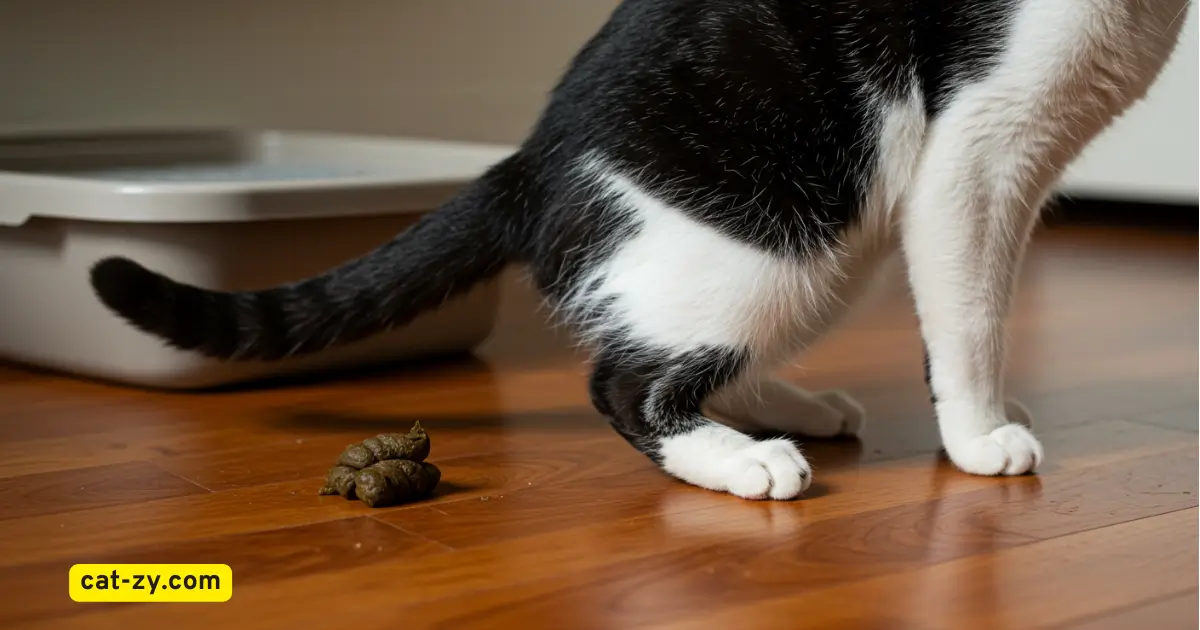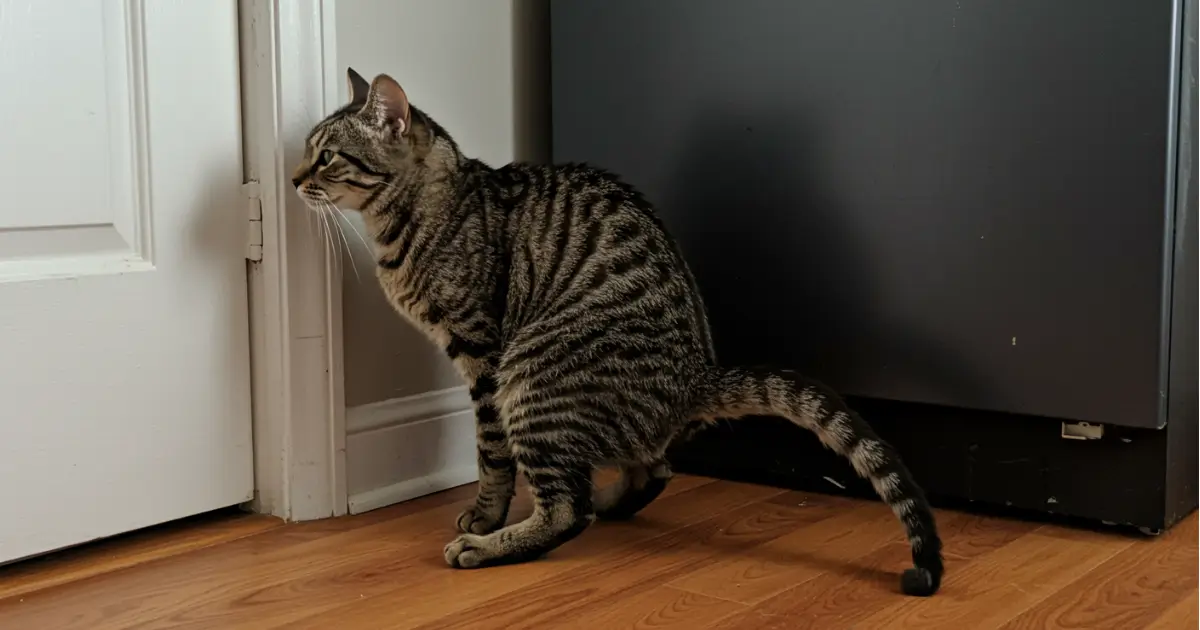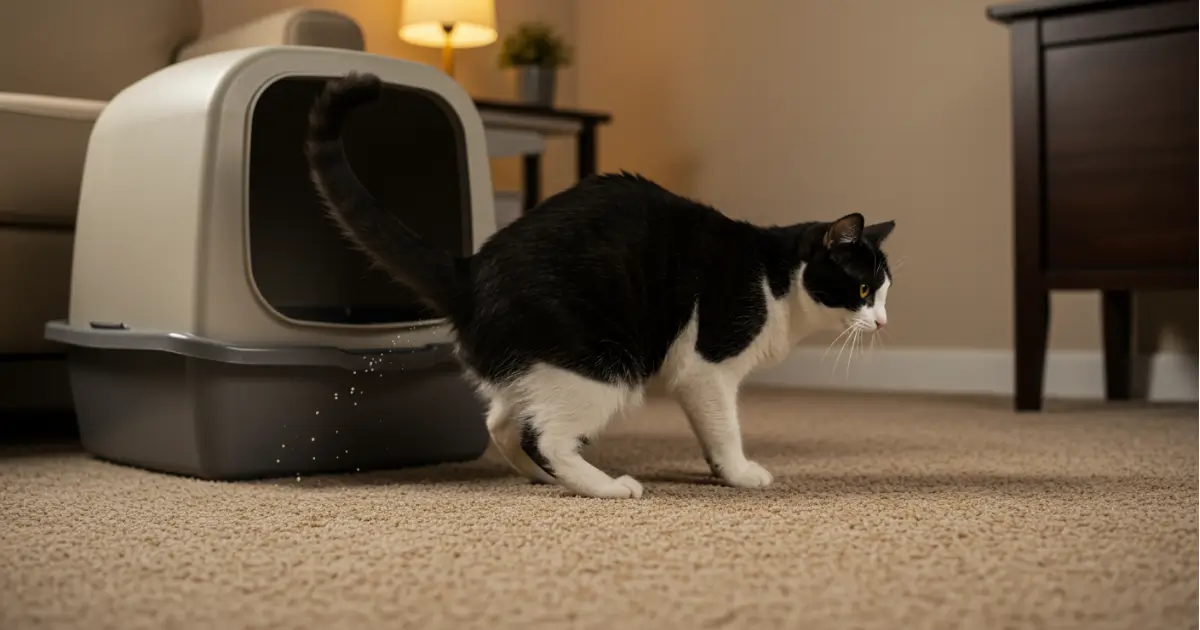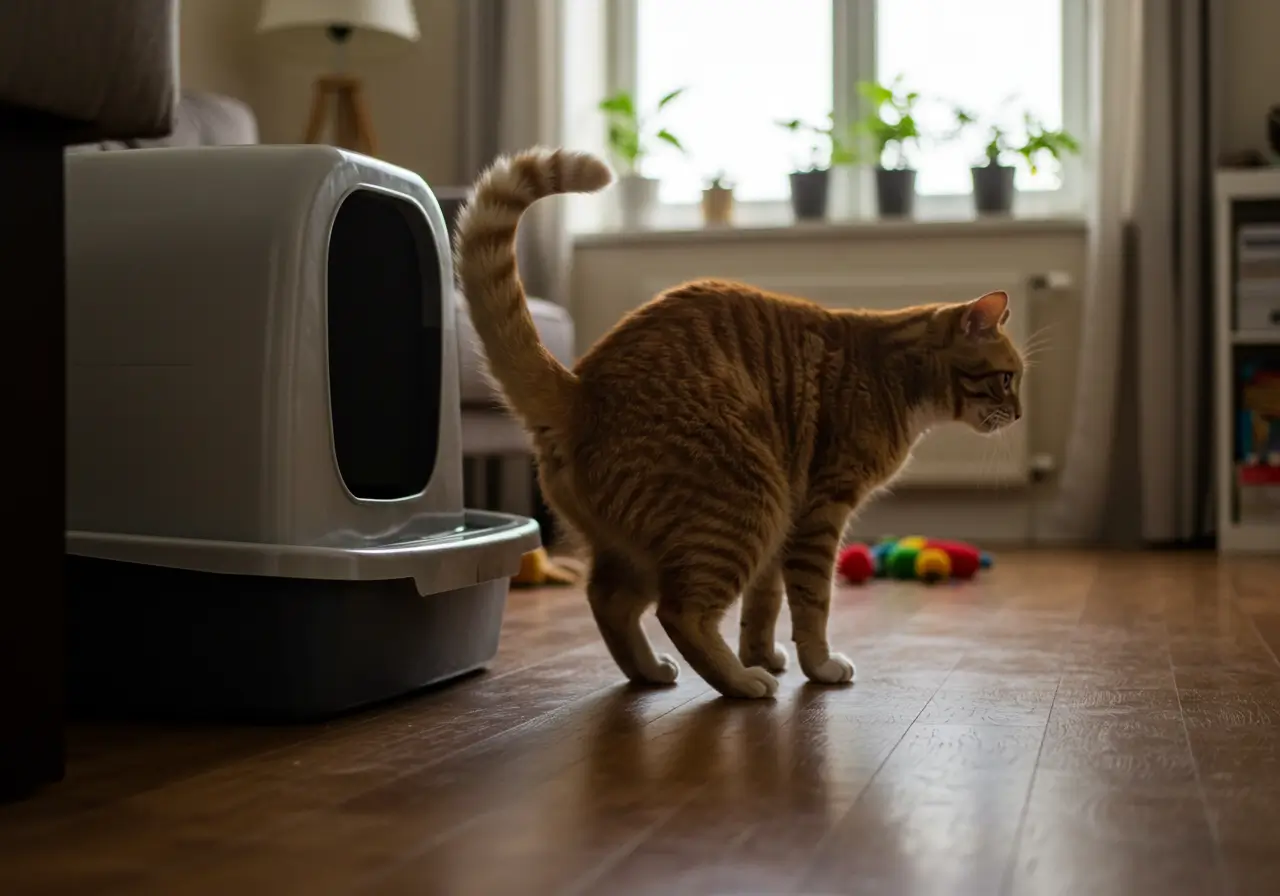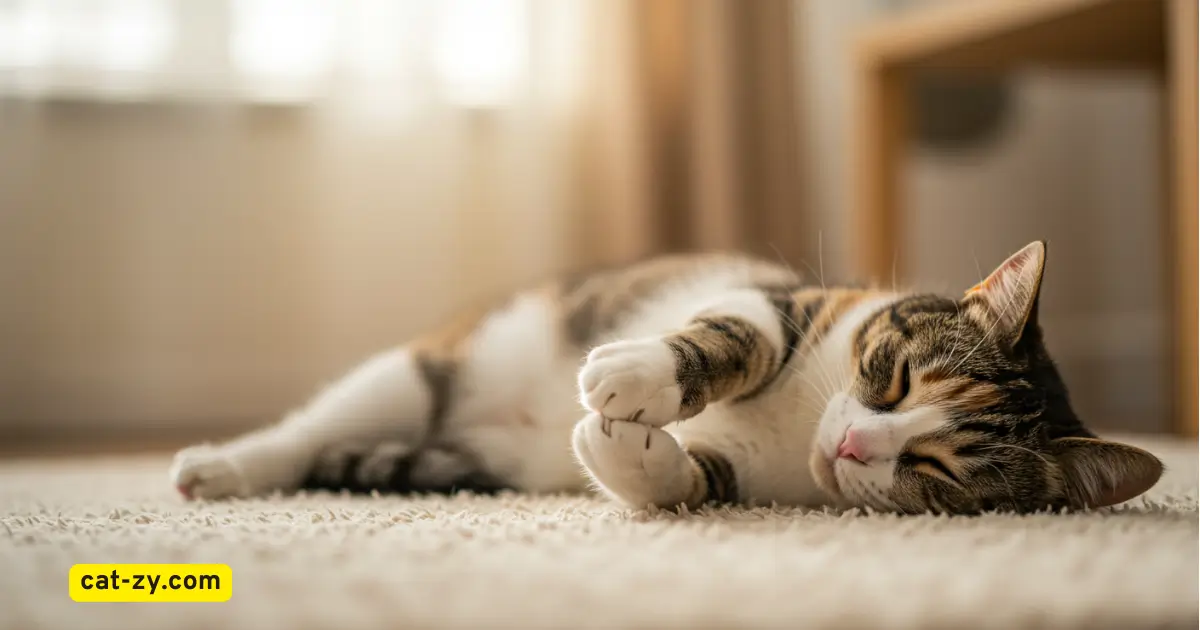Cat Pooping Outside the Litter Tray? 6 Effective Solutions to Stop It
Cat pooping outside the litter tray can happen for many reasons. It could be due to discomfort, changes in their environment, or a behavioral issue. Cats typically don’t go outside their litter box without a valid reason.
Every cat owner knows that sinking feeling when they find their cat has pooped outside the litter box. It’s not just messy—it’s a sign that something might be wrong.
Your cat’s sudden change in bathroom habits might indicate they’re experiencing discomfort or stress, which could lead to pooping outside the litter tray unexpectedly. This might be caused by new pets or changes in their environment. Many things can disrupt your cat’s routine.
This guide will help you figure out why your Cat Pooping Outside the Litter Tray. We’ll also give you practical ways to fix the problem. By finding and fixing the issues, you can help your cat go back to using the litter box as they should.
Table of Contents
Understanding Common Reasons for Unwanted Defecation.
Feline inappropriate elimination can be a complex issue often linked to deeper concerns. Your cat’s potty behavior might indicate underlying factors that need professional attention. Understanding these triggers is essential to helping your furry friend return to proper litter box habits.
igestive Concerns and Stomach Issues
A cat’s digestion plays an important role in their litter box habits. Cats facing digestive difficulties may have trouble using the litter box due to several key factors:
- Digestive discomfort causing painful bathroom visits
- Trouble with regular bathroom routines leading to discomfort
- Sudden, urgent bathroom needs due to irregular digestion
Soft or hard stools may indicate that your cat’s natural balance is off. Changes in their diet, the presence of unwanted guests, or inner unrest might be behind these signs, making it harder for your cat to stick to their regular litter box routine.
Age-Related Health Conditions
Senior cats face unique challenges that can disrupt their bathroom routines. Cognitive decline may cause disorientation, while reduced mobility can make traditional litter box access difficult.
- Reduced muscle strength
- Potential neurological changes
- Decreased spatial awareness
Pain and Mobility Issues
Conditions like arthritis can dramatically impact your cat’s ability to use the litter box comfortably. Musculoskeletal problems may cause pain during squatting or climbing, leading to feline inappropriate elimination.
A 2023 study revealed that cats with medical issues were over twice as likely to soil outside their litter box.
If you notice ongoing changes in your cat’s litter box habits, consulting an animal behavior specialist is essential for accurate diagnosis and treatment.
Behavioral Triggers Behind Cat Pooping Outside the Litter Tray
Understanding why your cat might be pooping outside the litter tray is key to solving the issue. Cats don’t poop outside because they’re angry. Their actions are often due to deep psychological and physical reasons.
The fight or flight response is a big factor in cat toilet training issues. When cats feel scared or stressed, they might poop right away. This isn’t a rebellion, but a natural response to threats.
- Loud noises can trigger fear-induced elimination, making your cat more likely to poop outside the litter tray
- Unfamiliar people or sudden environmental changes may cause stress
- New pets or household disruptions can create significant anxiety
Your cat’s bathroom habits are linked to their emotions. Stress-induced pooping is a survival mechanism, not a personal attack. Common triggers include:
“Cats communicate through behavior, and inappropriate defecation is often a cry for help or a sign of underlying discomfort.”
To tackle cat toilet training challenges, you need to be a detective. Look for subtle changes that might upset your cat. A calm, predictable space can help reduce unwanted cat defecation and make your cat feel safe.
Remember, patience and understanding are crucial when dealing with these issues. Your cat isn’t trying to make your life hard. They’re just responding to their environment in the best way they know.
Essential Litter Box Requirements for Cats
Creating the perfect litter box environment is key for solving cat litter issues. It helps prevent litterbox aversion in cats. Your feline friend needs a comfortable, safe, and inviting space to do their business.
Cats are very particular about their bathroom habits. Choosing the right litter box can significantly impact your cat’s comfort. It keeps your pet happy and maintains good hygiene.
Choosing the Right Litter Box Size
Size is important when picking a litter box. Here are some guidelines:
- Select a box at least 1.5 times the length of your cat
- Ensure minimum width of 13-15 inches for easy turning
- Choose boxes with low entrance heights (2 inches or less)
- Avoid high-sided boxes that challenge mobility
Strategic Placement Matters
Where you place the litter box is very important. Cats need:
- Quiet, low-traffic areas
- Easy accessibility
- Clear sightlines for safety
- Protection from high-activity zones
Multi-Cat Household Considerations
In homes with multiple cats, follow the n+1 rule. Provide one litter box per cat, plus an extra one. This helps reduce territorial conflicts. It ensures each cat has a clean, accessible bathroom option.
“A well-designed litter box is the key to a happy cat and a clean home.” – Feline Behavior Experts
Remember, a well-set up litter box can prevent many common bathroom behavior problems. It keeps your cat comfortable and content.
Environmental Stressors Affecting Cat Bathroom Habits
Your cat’s bathroom habits can change due to environmental shifts. House soiling often happens when their living space changes, causing them stress and discomfort. It’s important to understand these stressors to keep your cat using the litter box correctly.
Several environmental factors can lead to cat pooping outside the litter tray, causing frustration for owners
- Household Dynamics: New pets, family members, or big changes can upset your cat’s sense of safety
- Noisy appliances near the litter box that scare or distract your cat
- Busy areas that make your cat feel exposed while using the litter box
- Unexpected changes in daily routine or home layout
Cats need calm, predictable environments. When their space feels threatened or unpredictable, they may poop outside. This is not mean-spirited but a natural way for them to show stress or mark their territory.
To reduce stress, make a quiet, consistent space for your cat’s litter box. Pick a spot away from loud machines, with easy escape routes, and keep a steady routine at home. By doing this, you can stop unwanted house soiling behaviors.
Proper Litter Box Maintenance and Cleaning Protocols
Keeping the litter box clean is key to stop your cat from pooping on the floor. A clean litter box makes your cat happy and less likely to go outside the box.
Daily Cleaning Essentials
To keep your cat from pooping on the floor, clean the litter box every day. Your routine should include:
- Scooping solid waste at least twice daily
- Removing urine clumps promptly
- Maintaining a consistent litter depth of 2-3 inches
- Ensuring the box remains odor-free
Deep Cleaning Requirements
Deep cleaning the litter box once a week helps prevent floor accidents. Here’s how to do it:
- Empty the entire litter box
- Wash with unscented dish soap and hot water
- Dry completely before refilling
- Sprinkle a thin layer of baking soda to neutralize odors
Litter Type Selection Tips
Choosing the right litter can help prevent your cat from pooping outside the box. Cats typically prefer:
- Fine-grained, dust-free clay litter
- Unscented varieties
- Clumping formulas for easier cleaning
Pro tip: Give each cat its own litter box, plus an extra one. This helps prevent accidents and ensures your cats always have a clean, accessible bathroom option.
Signs Your Cat Might Need Professional Care
Cat pooping outside the litter tray can be a serious warning sign. It means something is wrong with your feline friend’s health. It’s important to know the critical symptoms that need a vet’s help.
When a Cat pooping outside the litter tray, it often points to an underlying issue affecting their overall comfort and happiness. Recognizing these key signs is essential, and seeking assistance from a behavior expert is advisable.
Be attentive to these signs that suggest your cat’s litter box issues may require professional attention:
- Changes in stool consistency – Diarrhea or unusually hard stools
- Blood present in the feces
- Visible signs of pain during defecation
- Sudden and persistent litter box avoidance
- Frequent unsuccessful attempts to eliminate
Changes in your cat’s routine, environment, or physical capabilities can lead to them avoiding the litter box. For instance, older cats may experience discomfort that makes accessing the box challenging, while stress from household changes can cause them to seek alternative spots. Ensuring the litter box is easily accessible, placed in a quiet area, and kept clean can help address these issues.
If your cat has litter box issues for more than a few days, consider consulting a professional. They can investigate the cause and offer a solution.
Identifying and addressing issues early can prevent more serious complications. It can also help restore your cat’s comfort and normal bathroom habits.
When discussing your cat’s behavior with a pet care specialist, be prepared to provide specific details. Share information about your cat’s recent behaviors, the frequency of any unusual incidents, changes in their diet, and any alterations in their surroundings.
Creating a Stress-Free Environment for Your Cat
Stress might be why your cat is eliminating outside the litter box. Creating a calm and secure environment can resolve litter box issues and enhance your cat’s comfort.
Territory Management Techniques
Cats need their own space to feel safe. Here are some ways to stop your cat from pooping outside the litter box:
- Provide multiple vertical spaces like cat trees and shelves
- Create quiet hiding spots using boxes or dedicated cat caves
- Ensure each cat has separate resources in multi-cat households
Setting clear boundaries helps avoid fights and stress that can lead to pooping problems.
Reducing Household Tensions
Anxiety can make cats avoid the litter box. Here are ways to reduce stress at home:
- Use pheromone diffusers to create a calming atmosphere
- Maintain consistent daily routines for feeding and playtime
- Minimize loud noises and sudden environmental changes
- Provide gentle, predictable interactions with your cat
By managing your cat’s emotional space, you can stop bad pooping habits and keep their mind healthy.
Effective Solutions for Preventing Future Accidents
Dealing with a cat pooping on the floor can be frustrating. But, there are several practical strategies to stop this behavior. The key is to understand your cat’s specific needs and create an environment that encourages proper litter box use.
- Clean soiled areas thoroughly with an enzyme cleaner to eliminate odors that might attract your cat back to the same spot
- Use deterrent methods like aluminum foil or double-sided tape in areas where cat pooping on the floor has been frequent
- Make the litter box more appealing by experimenting with different litter types and box designs
When learning how to stop cat pooping outside the litter tray, consider these targeted approaches::
- Location matters: Place litter boxes in quiet, accessible areas where your cat feels safe
- Ensure multiple litter boxes are available, especially in multi-level homes
- Choose litter boxes with low entry points for easier access
“Patience and consistent strategies are crucial in resolving inappropriate elimination behaviors.”
Each cat is unique, so you might need to try different solutions. Pay attention to your cat’s preferences and be willing to adjust your approach. Regular professional check-ups can also help identify any underlying issues contributing to litter box avoidance.
Training and Positive Reinforcement Methods
Cat pooping outside the litter tray can be corrected with patience, understanding, and a smart training plan.. It’s about using positive methods to teach your cat to use the litter box. This approach helps your cat learn to go to the litter box every time.
Reward-Based Training Strategies
To train your cat well, make a supportive space that encourages them to use the litter box. Here are some important tips:
- Give your cat high-value treats right away when they use the litter box right
- Use soft, encouraging words to praise them
- Keep a regular reward schedule to show them good behavior is rewarded
Correcting Unwanted Behaviors
When dealing with bad bathroom habits, remember that scolding doesn’t help. Instead, gently guide them and understand what they need.
- Gently move your cat to the litter box if you see them about to go outside it
- Thoroughly clean up accidents with enzymatic cleaners
- Use your cat’s scent to make a path to the litter box
Keeping your cat’s mind busy is key to less stress and fewer bathroom problems. Toys and puzzle feeders can keep them engaged and reduce anxiety that leads to bad habits.
Patience and consistency are your most powerful tools in cat toilet training.
Conclusion
Addressing litter box challenges, such as preventing your cat from eliminating outside the litter tray, requires a combination of professional guidance, environmental assessment, and training. Careful observation of your cat’s behavior and adjustments to their living space can be beneficial.
Each cat is unique, so it’s important to identify strategies that suit their individual needs. Consulting with professionals, implementing stress-reduction techniques, and optimizing the litter box setup can make a significant difference. Utilizing products like specialized litter mats and selecting appropriate litter types can also contribute to maintaining cleanliness and comfort.
Being patient and making small changes can make a big difference. If problems keep happening, talk to a vet or animal behaviorist. They are able to offer guidance tailored to your cat’s specific requirements.
Your effort and patience will make your cat happier and healthier. By solving litter box problems with care and strategy, you can strengthen your bond with your cat.
FAQ
Why is my cat suddenly pooping outside the litter box?
Cats may eliminate outside the litter box for various reasons. Factors such as digestive discomfort, stress, or environmental changes are common contributors. It’s important to consult with an expert in animal care to rule out any underlying issues.
How many litter boxes should I have for multiple cats?
It’s recommended to provide one litter box per cat, plus an additional one for extra convenience. For example, two cats need three litter boxes. This helps avoid fights and makes sure each cat has a clean place to go.
Is it possible for stress to make my cat defecate outside the litter box?
Yes, stress can make cats poop outside the litter box. Changes like moving, new pets, or loud noises can upset them. This can lead to them going in places they shouldn’t.
What is the recommended frequency for cleaning my cat’s litter box?
Clean the litter box every day by removing solid waste and clumps. Change the litter completely every 2-4 weeks, depending on your cats and the litter type. Keeping it clean makes your cat more likely to use it.
What medical conditions can cause litter box avoidance?
Medical issues like constipation, diarrhea, or arthritis can make cats avoid the litter box. Older cats might have trouble getting in or out because of joint pain or memory loss.
How can I make my litter box more attractive to my cat?
Choose a big, clean litter box in a quiet spot. Use litter that your cat likes and that doesn’t smell. Make sure it’s easy to get to and clean it often. Try different litters and boxes to see what your cat prefers.
When should I take my cat to a professional for litter box issues?
Observe if your cat frequently avoids the litter box, experiences changes in their stool, shows discomfort when eliminating, exhibits unusual behavior, or if the issue persists despite adjustments.”
Is it possible to teach my cat to reliably use the litter box?
Yes, you can train your cat with treats and praise when they use the litter box right. Refrain from punishing them, as it may escalate the situation. Be patient and consistent for the best results.
How do I clean areas where my cat has pooped outside the litter box?
Use a special cleaner for pet waste to get rid of smells. Clean the area well to remove any scents that might attract your cat. Avoid cleaners that smell like ammonia, as they can make your cat go there again.
Can diet affect my cat’s litter box habits?
Yes, what your cat eats can influence their litter box habits. Changes in diet or food sensitivities can lead to stomach discomfort. Consult a professional about your cat’s food and choose options that are gentle on the stomach.

